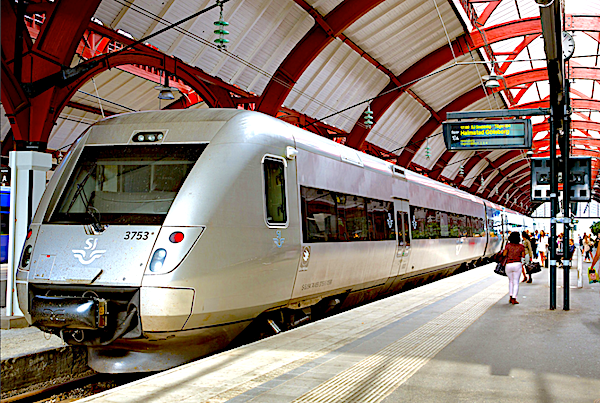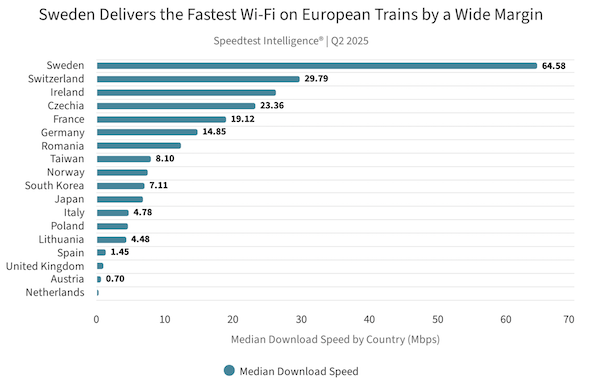

Ookla has analyzed country-level train Wi-Fi performance across Europe and Asia, using Speedtest Intelligence.
Europe and Asia’s rail networks, long heralded as a backbone of economic competitiveness, are now judged not only on punctuality and comfort but on the quality of the digital experience onboard. High-quality train Wi-Fi has shifted from nice-to-have to essential rail infrastructure. Commuters expect a home broadband-like experience for streaming, work calls and gaming while crossing the Swiss Alps or skirting Mount Fuji.
Where countries treat train connectivity as rail infrastructure and pair onboard Wi-Fi with rail-specific infrastructure (trackside, LEO satellite or both), everyday outcomes improve measurably for passengers.
The study uses crowdsourced Ookla Speedtest data to benchmark country-level train Wi-Fi performance across Europe and Asia.

Key Takeaways include:
- The gap separating Europe’s best and worst is startling. In Q2 2025, Sweden set the pace for train Wi-Fi in Europe with a 64.58 Mbps median download, followed by Switzerland (29.79 Mbps) and Ireland (26.33 Mbps). Laggards like Spain (1.45 Mbps), the UK (1.09 Mbps) and the Netherlands (0.41 Mbps) featured the poorest outcomes, with download speeds as much as 158 times slower than top-performing Sweden.
- Legacy Wi-Fi tech drags many rail networks. Across the European markets studied, nearly two in five connections still run on Wi-Fi 4 (a standard dating to 2009), and ~22 per cent use the lower-capacity, more congestion- and interference-prone 2.4 GHz band. The UK still sees over half of all rail connections on Wi-Fi 4, with 38 per cent on 2.4 GHz. In Poland, rail connections remain almost entirely on Wi-Fi 4 and the 2.4 GHz band.
- Band and Wi-Fi gen matter, but backhaul is the real bottleneck. Within-country comparisons show substantial uplifts for 5 GHz vs 2.4 GHz (e.g., +328 per cent in Germany) and Wi-Fi 5 vs Wi-Fi 4 (e.g., +241 per cent in Germany). Yet countries that feature a more modern Wi-Fi mix and thus drive greater use of the 5 GHz band, like Spain and Italy, can still underperform on speeds. This demonstrates that backhaul (i.e., the connection between the train’s roof antennas and the public mobile networks), not just cabin Wi-Fi, is the dominant driver of performance.
- Asian rail networks feature modern Wi-Fi mix and lower latency but are not always faster. Taiwan posted the lowest latency and the only material Wi-Fi 6 share (~20 per cent), while Japan and South Korea showed virtually no legacy Wi-Fi 4 or 2.4 GHz usage. Across Asia, typical median download speeds (6-8 Mbps) cluster below Europe’s leaders but above its laggards, reflecting different policy approaches (i.e., greater emphasis on cellular than Wi-Fi).
- Policy fingerprints are unmistakable and outweigh topographic and demographic factors. When governments and operators treat mobile networks as core rail infrastructure, and invest in dedicated trackside systems, higher-order MIMO with multi-operator bonded train-mounted antennas, and RF-permeable rolling-stock window retrofits, outcomes improve dramatically.
Advanced Television
